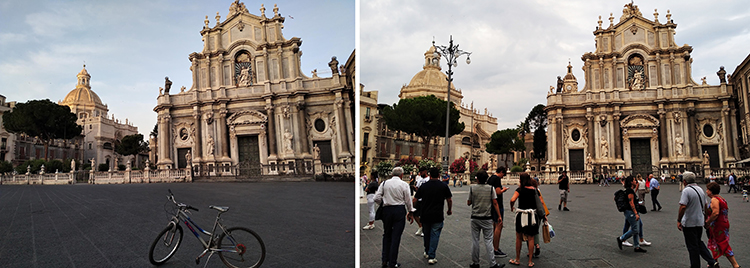
Through and beyond horror (space and time) vacui in Catania?
– from Elisa Privitera, Sicily, IT, 22.07.2020
In 2007 the renowned Italian artist Franco Battiato was singing “vacuum”, considering it both in terms of space and time, referring to it like the one stemming from the superficiality and frivolousness of our (pre-COVID19) delirious society, and using sentences like the following:
“Time there is no time, more and more anxious
I chase our time empty of meaning, sense of empty
And people, how many people, a sea of people in a vacuum”
The pandemic has undoubtedly interrupted such voids coming from a frenetic lifestyle, has it maybe created other ones?
Surely, it is worth investigating what we mean by saying “empty space”. If a space is empty, it is empty with respect to what? How does the feeling of emptiness influence our relationship with space in the short and long term?
The existing tension between full/empty-space/time gives us reflective insights into what we can learn from the lockdown experience.
Do we have a fear of free space and time? Most likely yes, we have.
Such a feeling of discomfort has ancient roots.
It is traceable back to the Greek period when the word “kenophobia” was used to define the irrational fear of voids or open and empty public space. At a later time, in visual art, there was the expression “horros vacui” coming from Latin, precisely meaning “fear of empty space” and indicating the practices by artists to fill the entire surface of an artwork with as much detail as possible, making every empty space finally jam-packed.
The relationship void/space/society was also investigated from a philosophical perspective. “Horror vacui” reflects Aristotle’s idea that “nature abhors an empty space.” That is why each gas or liquid tends to fill any space left free, which is actually consistent with the idea that each space is itself matter that can not be empty. In contradiction with this theoretic stance, the ancient Pythagorean school and the atomic philosophies maintained that the existence of vacui itself was not only possible but, above all, it was necessary for having other things existing and interacting with each other. For instance, thanks to the emptiness between atoms, their movements are possible.
Finally, the controversial relationship between empty and full space, not only represents the basis of the architectural design but involves personal emotions. From a neurological point of view, the path of emotions is rooted in the perception coming from the environment all around. Likewise, according to Paul Freire, “the mind thinks where the feet are”, i.e. our body, emotions, and thoughts are deeply connected with the surroundings. This also rings true from an epistemological perspective; the feminist scholars maintain that knowledge is situated, partial, and deeply connected to the context around your body (Donna Haraway, 1991).
For sure, to be in or to cross a space that is full of people or completely empty is not the same from an emotional point of view.
Talking about the newly created voids (at least the spatial ones) due to the COVID-19, during the lockdown in Catania (Sicily, Italy), as in many other cities, when people had to stay at home by law, the public space was emptied out like never before; it was considered an unsafe place and, anyway, it was illegal to stroll.
In empty public spaces, in substitution of the chaos, there was calm, instead of the streets full of cars, there was the silence and the sound of nature, instead of frenetic and running thoughts, there was a slow time. Although Jan Gehl maintains that the public space is the core of the life between buildings (1971), in order to enjoy a good quality social life between buildings, maybe this long quarantine has taught us that we should not be afraid of the vacuum, but we should learn from it the most we can: the lack of honks, the sound of nature, the clean urban air. We could learn the fact that our ecological footprint is really too invasive, or that what we really need is always less than what we thought before.
In the unpublished story, the novelist Elio Privitera says, “in the empty space….only agglomerations of dust and the ghosts of my memories wander…empty spaces are such a perfect representation of the end of something (Privitera, 2017)”
This emptiness during quarantine, more than symbolizing the end of something, could it represent the beginning of something else? Talking about the newly created voids (the ones of time), COVID-19 has provide us time to stay with ourselves. Rather than being something to avoid, because of its sense of emptiness, by staying in places full of people, as told by the aforementioned song, the vacuum can also be seen as an opportunity to be filled with a new awareness of our contemporary society and our position with respect to it.
POST(COVID)CARDS
